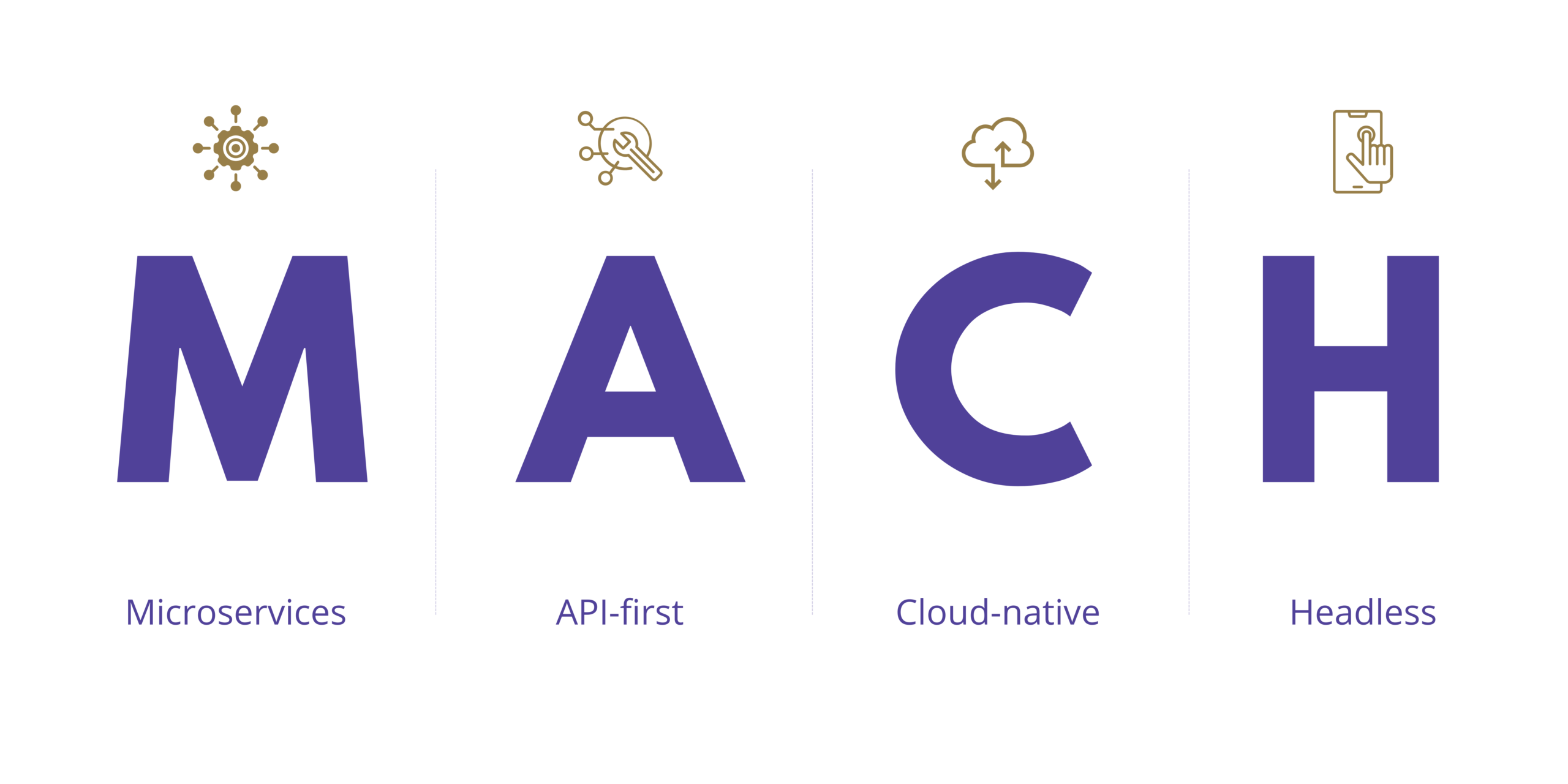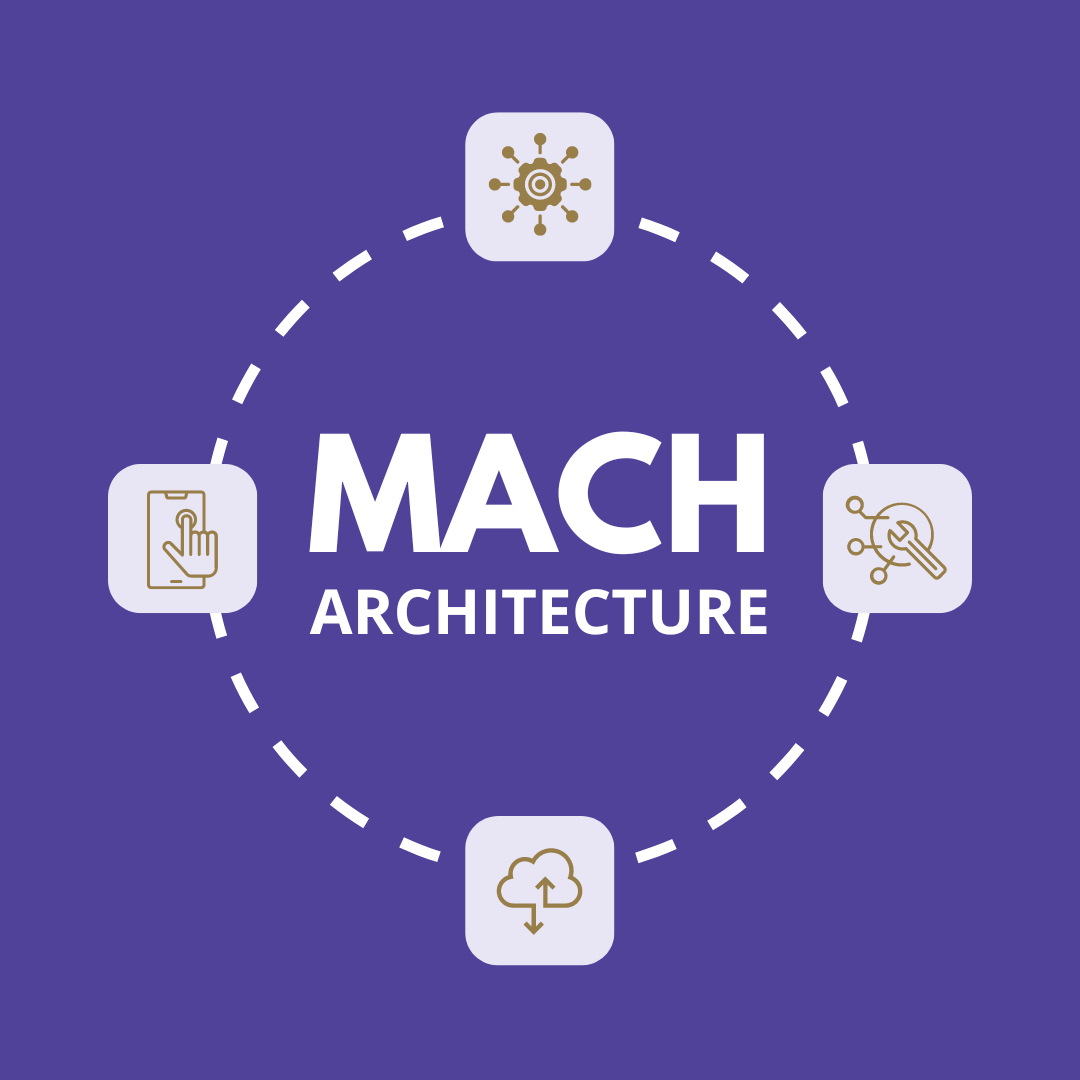- Introduction
- 1. – Understanding MACH architecture
- 1.1 – Microservices
- 1.2 – API-first
- 1.3 – Cloud-Native
- 1.4 – Headless
- 2. – The MACH Alliance
- 3. – Technological revolution or simple trend?
- 4. – BONUS: The MACH alliance blog, a valuable resource
MACH architecture is a set of technology principles that has been getting a lot of buzz since it emerged in 2020. ”Microservices, API-first, Cloud-native SaaS, and Headless” – it sounds like a recipe for transforming your tech stack into something very attractive! But behind the jargon and acronyms lie nuances to consider. In this article, our experts give you their point of view.
Understanding MACH architecture
MACH architecture is based on four key principles: Microservices, API-first, Cloud-Native SaaS and Headless, forming the acronym MACH. The aim is to promote an agile, modular approach to the development of applications and websites… We explain!

Microservices
This approach breaks applications down into smaller services that operate independently, making it easier to update and improve specific functionality without disrupting the whole system.
You can think of microservices as a Lego construction: each specific piece contributes to the whole. In the same way, a Lego represents a specific service within your application, such as user management, payment processing or report generation. Each service is of course designed to integrate seamlessly with the others, while fulfilling a distinct and specialised function. The idea behind this is that if each part is developed independently, it speeds up the development and deployment phases. This approach offers exceptional reliability and openness, enabling continuous evolution and rapid adaptation to changing user needs, all without disrupting the integrity of the whole.
Unlike all-in-one solutions, which can compromise performance in certain areas, this approach allows you to choose specialised solutions for each functional area. This means that each component of the architecture is a leader in its field, offering optimised functionality and performance for the specific needs of your business. By opting for this type of solution, you benefit from continuous innovation from multiple specialist suppliers, guaranteeing access to the latest technological advances in each area (PIM, DAM, CMS, UX, etc.).
API-first
This means that priority is given to the creation of robust application programming interfaces (APIs) that enable the various services and applications to communicate effectively with each other.
Imagine your MACH application as a universal translator at an international conference, enabling people of different nationalities to communicate efficiently and error-free. APIs act like this translator, facilitating communication between different IT services and applications, even if they weren’t initially designed to work together.
This API-first approach allows each component of your MACH architecture to operate independently while being connected to the rest of the system, enabling seamless integration of new functionality.
Cloud-Native
With the MACH approach, applications and websites are designed to take full advantage of cloud resources, making them more flexible and scalable.
Using the cloud offers true scalability by enabling your platform to be hosted in a highly flexible virtual environment. Your platform becomes like an elastic band: it can grow or shrink according to your needs, guaranteeing dynamic adaptation to fluctuations in traffic. This Cloud-Native SaaS approach also ensures that your application remains constantly up to date, with the latest features and security patches installed automatically.
Headless
The Headless concept involves separating the front-end from the back-end, enabling faster, less disruptive updates and tests.
This concept can be illustrated by comparing it to a puppet theatre where the puppeteers can change the puppets’ sets and costumes quickly behind the curtain without the audience seeing the changes. In headless development, the ‘front-end’ (the part that the user sees) can be modified and improved independently of the ‘back-end’ (where the data is processed and stored), offering more freedom to improve the user experience without disrupting the internal workings.
In short, the headless approach, where the presentation layer is separated from the business logic, allows greater freedom in creating attractive, high-performance user interfaces (UIs) on all devices, improving the user experience without compromising overall performance.
The MACH Alliance
What is the MACH alliance?
The MACH Alliance is a not-for-profit organisation founded in 2020, dedicated to the promotion and adoption of the MACH architecture in the technology industry. The founders of this alliance are renowned technology companies such as Adyen, Akeneo, Stripe, AWS and Vercel.
Its aim is to democratise this architecture model and help businesses make the transition to it. The Alliance advocates an information system that is open, agile and fast, making it easier to adapt to the changing needs of the digital marketplace. It brings together major players in the technology sector, all sharing a common vision of a more flexible and scalable technological infrastructure. In short, it is above all a mindset that these players want to communicate to businesses.
What has the MACH alliance actually achieved?
In reality, the MACH architecture has not introduced any revolutionary new concepts. The principles on which it is based have existed for years in the field of software development. What the MACH alliance has done is simply to highlight and consolidate these practices under a common name: “MACH”.
Cette initiative a permis de rendre ces principes plus accessibles et compréhensibles pour un public plus large, ce qui a stimulé leur adoption parmi les professionnels du secteur ainsi que parmi les entreprises cherchant à moderniser leurs infrastructures technologiques.

Technological revolution or simple trend?
MACH architecture is more than just a trend. It is an evolution in development practices that responds to the modern needs of digital businesses, marking a transition towards more robust, flexible and adaptive systems. For companies seeking to remain competitive in today’s economy, understanding and potentially adopting this architecture could be a crucial part of their development strategy.
Why is this important for your company?
- Flexibility and scalability: With MACH architecture, your business can quickly adapt to market changes and integrate new functionality without major disruption, delivering true operational agility.
- Improved performance: MACH applications can handle high volumes of traffic more efficiently and are optimised for maximum performance, essential for growing businesses.
- Personalised user experience: MACH’s headless model enables richer, more personalised user experiences, which is crucial in a market where user engagement is key.
MACH architecture: for all types of development?
MACH architecture is the subject of much debate, and for good reason: it is not necessarily the ideal solution for all types of development. While it can offer significant advantages in terms of performance, flexibility and scalability, its adoption can also present challenges and drawbacks.
When is this solution appropriate?
In certain contexts, we can wholeheartedly recommend MACH architecture:
- In projects where modularity and flexibility are essential, such as complex e-commerce applications, where different parts of the application require frequent, independent updates.
- For companies requiring seamless integration between different systems and services, such as inventory management systems, payment platforms, CRM tools, messaging services, etc.
- When scalability and upgradability are top priorities.
The limits of this methodology
MACH architecture offers substantial advantages for the development of complex and scalable applications, but it is not always the ideal solution for all types of project. At DJM digital, we carefully assess the specific needs of each customer and propose more traditional architectures where this is deemed more appropriate. Here are some cases where a traditional architecture might be recommended over a MACH architecture:
- Small-scale projects: For small businesses or projects with simpler functional requirements, a monolithic architecture may suffice. These projects often don’t require the complexity or scalability that MACH offers, making a more traditional approach more cost-effective and easier to manage.
- Start-ups and proof-of-concept (POC): Start-ups in their early stages or projects aimed at validating an idea (POC) can benefit from faster time-to-market with less complex architectures. The key here is often to test an idea with the minimum of resources before committing to more scalable and expensive solutions such as MACH.
- Projects not expected to generate significant traffic : If a project is not intended to manage large volumes of traffic or require dynamic scalability, the benefits of a cloud-native, microservices-based architecture may not justify the additional costs.
- Time constraints: Deploying a MACH architecture may require more time for planning, implementation and testing than traditional architectures. For projects with tight deadlines, opting for a simpler solution can enable faster delivery.
- Maintenance costs and management of microservices: Managing multiple microservices requires continuous monitoring and specific technical expertise, which can increase maintenance costs. For businesses that do not have the resources to manage this complexity, a more traditional architecture may be more manageable and less costly.
Advice from our experts
In short, although MACH architecture has undeniable advantages, adopting it is not always the optimal solution. Before committing to this approach, it’s crucial to carefully assess the specific needs of the project and the resources available. Our experts at DJM digital are here to support you in this process, helping you to make informed decisions about the approach, tools and technologies to adopt. Our aim is to strike the right balance between technological innovation and operational practicality to ensure the success of your projects.
The DJM approach: Best-of-breed

The Best-of-Breed approach is a strategy where we choose the best solutions available on the market for each specific function within your company, rather than relying on a single system that tries to do everything. Imagine being able to choose the best experts in each field, rather than hiring a single person to manage all aspects of your project. This method allows us to combine specialist software that excels in its specific field, ensuring optimum performance, flexibility for upgrades and easy adaptation to your company's future needs.

BONUS: The MACH alliance blog, a valuable resource
The MACH Alliance blog is a valuable resource offering a wealth of information on the MACH architecture and its impact in the technology field. It provides in-depth analysis, case studies and news on recent trends and developments in the MACH ecosystem. Written by experts and Alliance members, the blog posts offer unique perspectives on the challenges and opportunities of adopting the MACH architecture.

Meticulous and perfectionist, Céline specializes in the creation of SEO-oriented content. But these are not her only assets! She also puts her creativity at the service of our Social Media Strategy team to create ultra-targeted campaigns designed to convince and convert.



